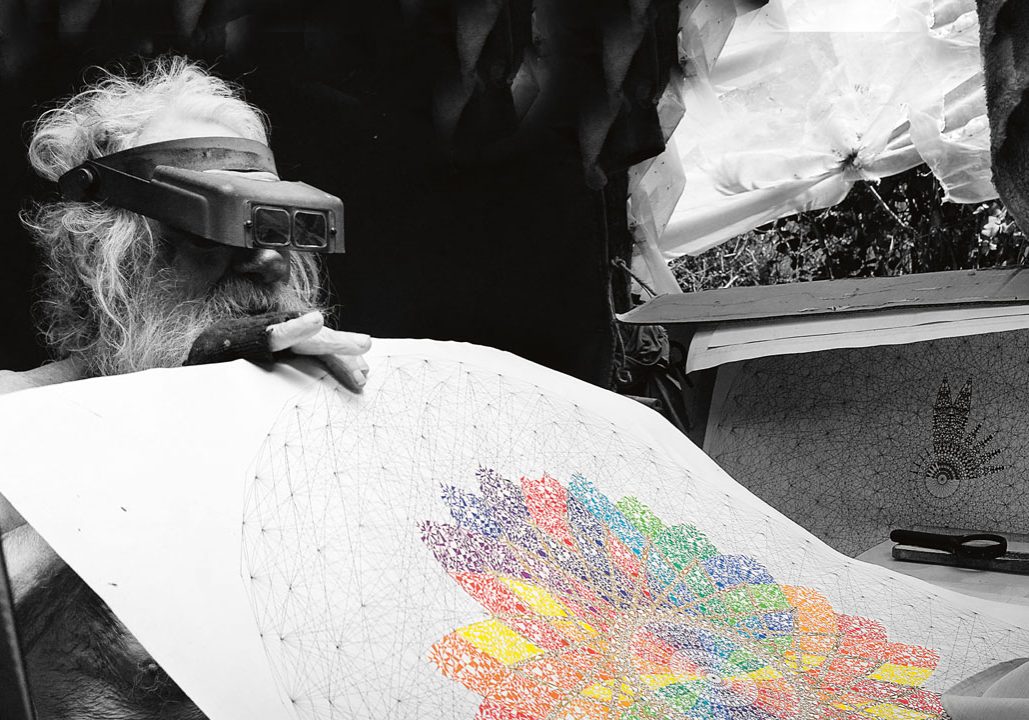
The one and only... Cliff Barber
Yoga teacher Cliff Barber, 88, now lives a reclusive life in rural Greece creating beautiful, mathematical-like mandalas. Writer and photographer C. Borgen catches up with him to discuss the release of his work
Cliff Barber, now 88, was born in Illinois, USA. He was among the first to introduce yoga from India to the West back in 1969. His life story is a classic one of a broken youth, who as an adult enjoyed financial success in the adventurous treasure diving business but found out that money could not fulfill his soul. He turned towards philosophy and yoga, never worked for money again and lived literally under a tree in Greece teaching yoga and studying pure mathematics ever since. Although this story is a classic one, I never actually met anyone who lived it.
Finding Cliff Barber
Cliff gave me my first yoga lesson in Goa, India in the early 1980’s. Ten years later, I tried to find him in Greece to help me with a project considering the infamous Bock Saga. In this Saga, the story of mankind as narrated by the Bock family, the alphabet played a crucial role. Cliff had a visionary insight considering this alphabet. I had seen photographs of his drawings made up of circles and lines. Within those circles and lines, he had found the origins of our letters. He could show that the alphabet consisted not of random signs, but rather were derived from mathematical principles that gave a specific meaning to the letters. The letters of the alphabet were arranged in a circle. The lines through the connection points with this circle and other circles of the so-called Flower of Life, created special relations between the letters. These relations between the letters in the circle in turn created new meanings. I did not find Cliff that year.
In May 2016 I went back again to find him. I still wanted to know about the alphabet and how he had found its roots in mathematics. Again, I had some vague directions, but this time it was easier to find him because everybody in the area seemed to know about him, although nobody had actually seen him. It took me only a couple of days before I spotted, secluded in the trees and bushes, the contours of his dwellings. Through a hardly discernible trail, I neared the construction, consisting of beams, sticks, blankets and plastic sheets. I peeked in through the side and saw Cliff sitting on some pillows on the clay floor, on his head a watchmakers’ visor with an inbuilt magnifying glass and in his left hand a second large magnifying glass. He was looking through both at a hole in a rag on a glass table, and painting within it something extremely minuscule. His hut contained, apart from this work space, a mattress, a fire place, some cats and lots of books on mathematics.
I made myself known. He looked up from his work and took off his magnifying visor. He did not recognise me, which is understandable considering we had not seen each other since we first met in the early 1980’s. I, however, recognised him. I knew who it was I was looking for and in all those 35 years since our first meeting, he had hardly changed.
I asked him about the drawings and the alphabet. He answered that he was no longer interested in that subject and had not thought about it since he had come to Greece in 1989. Although he still believed he had found the mathematical origins of our Western and other alphabets within the Flower of Life, he thought of it as inconsequential to him. He argued these alphabets are man-made and thus a cultural expression that did not contain universal truth. Well, that was the end of my mission.
In the days that followed, we talked a lot about the good old days in India, exchanged gossip about people we both knew and what had kept us busy throughout all the years that had passed.
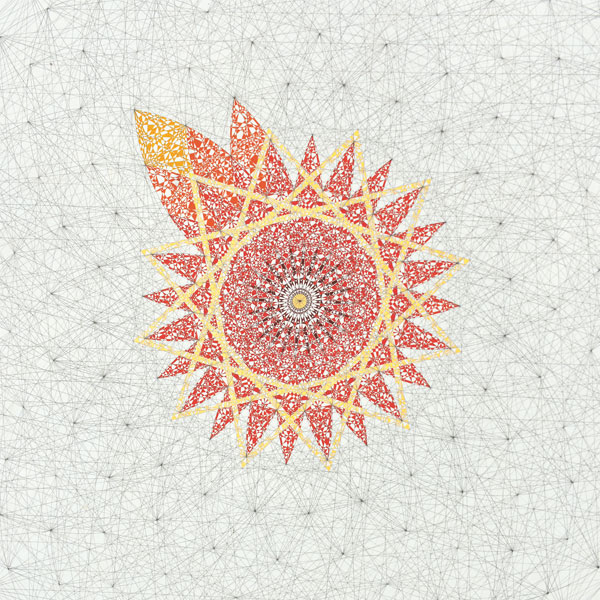
He told me he never stopped working on the drawings. He still worked on them every day for several hours.I was amazed that in that little dusty hut, too small to even stand up in, he could make these elaborate near-perfect drawings, just with a regular school compass, a ruler and a pencil. His method, both then and now, consists of placing a sheet of paper on top of a plate of glass, followed by a rag to protect the drawing from the dust flying around in the air. In the rag is a little hole, which allows him to reach the paper with his pencil and the tiniest of brushes.
Mandala man
In a corner of the hut lay a cylinder that contained drawings he had made in the past. I asked him to show them to me. He said that those were not interesting because since making them, his work had developed so much, that they were not worth looking at: “They are just doodles,” he insisted. I tried to persuade him with arguments such as: “But they are interesting to see the development of your line of thinking”, and “They might not be interesting to you, but for ordinary people who are new to this kind of mathematical beauty, they could be worthwhile to see”. And, since Cliff does not like to refuse anything to anyone, he finally showed me the drawings.
As we carefully took the drawings and paintings out of the cylinder, the bugs that had been hiding within it scuttled away. My jaw dropped, amazed at the beauty radiating from the lines, circles and painted surfaces that unfolded before my eyes. There was a sharp contrast between the geometrical perfection in minute detail and the stains caused by the weather and the beetles that had been living and breeding between them all those years.
One more thing startled me. None of them were finished. Cliff explained it as follows: “It takes about one or two weeks to draw the lines and circles. To finish the painting takes about five months. While working I always think about how to do it better. When I think of some improvement, I quit and start a new painting with the new string of thoughts to guide me. Every painting that is not finished is proof that I keep developing the process of finding and expressing universal truth in mathematics, which is my intention. I started this 50 years ago and only recently I finished my first painting that I consider complete. Now you understand why these drawings in front of us are worthless to me. I passed on to much higher levels.”
I tried to convince him of the beauty and importance of his artwork and he replied that it was not art but an attempt at mathematics. After this went on for a while, I asked him for permission to photograph the drawings and paintings. Although he saw no point in doing so, he conceded. I took them to my hotel, a typical Greek building with shining white walls that reflect a lot of light, the perfect place to take pictures.
It took me a whole day to photograph them all. It was a lot of work to chase the bugs out of them and straighten them up. As I was working on the porch in front of the reception of the hotel, many local people passed and watched what I was doing. Everybody seemed to know about Cliff Barber and he was held in high esteem, although nobody had actually met him. He is considered to be a guru, a holy man and even more. Only now, I started to realise his reputation, and only later I realised that this reputation extended worldwide. The next day I asked him what he thought of that. He replied that he is not holy or anything like that, but just a yoga teacher who does not see a hairdresser very often.
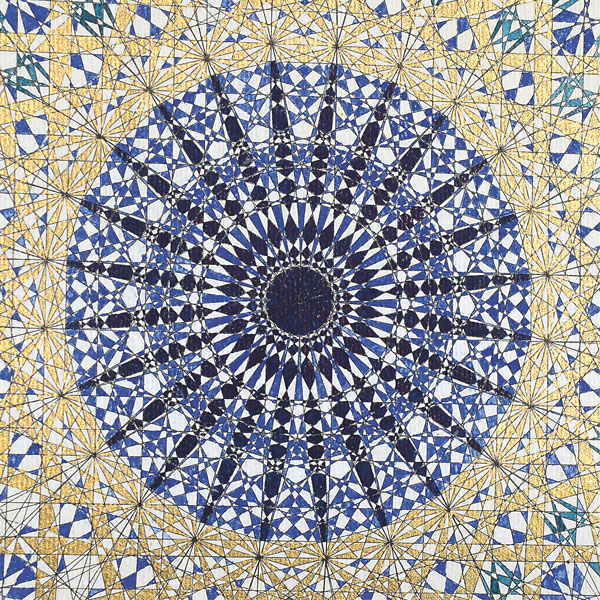
MY YOGA JOURNEY
Here, Cliff Barber details his yoga journey in his own words: “In the 1950’s I became a treasure hunter. I was deep sea diving for sunken ships and looting them of precious materials like tin and copper. In 1961 I got the diving rights to a ship wreck, which was very rich of these materials. It made me a lot of money, but the lifestyle that came with it led to my downfall. Apart from the money my main breaking point were girls, too many girls, and bending a few rules too. At the age of 35 my whole life fell apart, I fell apart. It was totally my own fault.
In 1968 a friend gave me a meditation on the 10 archangels. That started my studies in the Kabbalah. During this time, I made the first drawings of the Flower of Life. It consists of a circle, with other circles surrounding it whose centre points sit on the circumference of the first circle. I was too poor to have a proper compass and ruler, so I used a pot of peanut butter and a steel car part to help me draw.
I did not realise at the time that drawing circles and lines and studying yoga would fill my whole life from then on. What I did realise was that my old life of chasing ever-growing needs was over and that I would dedicate my life to searching for universal truth, which would bring me closer to the divine. My break-up with my old lifestyle was definite. During that great transition in 1969, I decided I would never work for money again.
In 1972 I started teaching yoga for the first time. Four years after that I met David Williams when he came to Maui. He was the first Westerner to learn all of the eight Ashtanga series of yoga from Sri Krishna Pattabhi Jois. He watched me doing my practice and asked me if I wanted to see his. I realised he was much more advanced than I was. He is considered to be one of the great international teachers of yoga now. During the next 35 years I spent lots of time with him doing yoga.
Two years later I met Krishna Pattabhi Jois himself, when he came for a three month visit to the USA. I realised I had to go to India to study yoga in depth. A boy who had worked on the treasure hunting boat, whom I had helped during difficult times when he was young, had in the meantime become a rich man. He gave me the money to travel to Mysore where Krishna Pattabhi Jois had his training centre.
I resisted the strong physical exercises. From the beginning, for me yoga was a mental practice. I thought yoga was a spiritual way to know God. It seemed strange that one should have to go into difficult positions to get to know Him. But I did. In 1981 I went back to Mysore to study all eight series.”
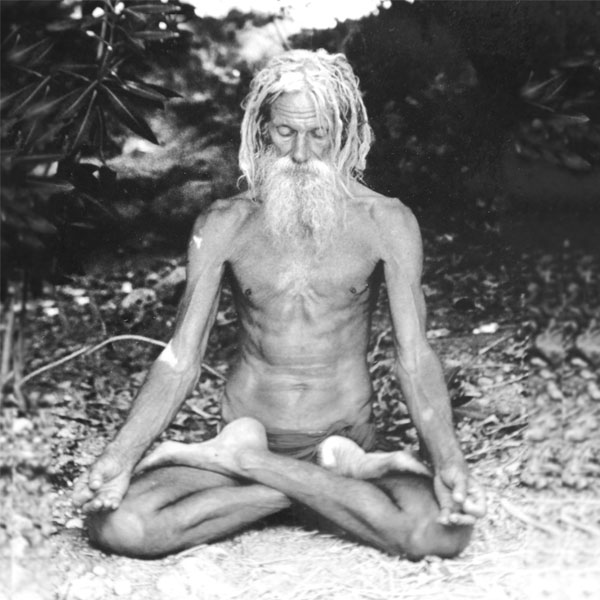
I AM NOT A YOGI
“I am not a yogi. I study yoga. It is a form of orthodox philosophy from India. It is not a religion. Philosophy is the search for truth. I am interested in universal truth. I find it in mathematics. It expresses itself in the Flower of Life.
I do not believe that God interferes in our world, but mankind does. The universe is a manifestation of God and we interfere. Our creations cause their own problems. That’s why I believe we shouldn’t create. It is better to be receptive.
What is in the afterlife? I don’t know, but it seems there must be something. I have no idea what. The Buddhist meditation on death has three steps: 1) You will die. 2) You don’t know when. 3) You can’t take anything with you.
The most important thing is to be glad when you die and not sorry. You should live your life to the fullest so you don’t mind dying whenever the time is there.
It all comes down to circular motion. What’s the difference between life and death? Motion. Some things are very slow, but if they are moving they are alive. All the time I learn there are many levels of meaning and understanding.
I came to Greece to study mathematics. Only after studying Plato, Archimedes and other Greek thinkers in depth, did I discover there is a big difference between pure mathematics and applied mathematics. The latter is used for the construction of things. Plato said: ‘Stick to pure mathematics, not the applied math, which takes your mind away from the divine to the mundane.’ According to him you should start at the age of 20 and then you should have grasped it at the age of 30. In my case I still haven’t grasped it. I started when I was 37 and now I am 88.
I think that the paintings could be a help in meditation. My wish is that every child in the world has a print on the wall and can watch it from his bed and dream away.”
Since writing the book some things happened to Cliff and the little paradise he lives in. His hut under the tree burned down to the ground when lighting a fire to keep warm. In a haze of smoke, he barely managed to escape the falling burning roof. With a lot of help from friends a new hut was built. Then came a flood. After big rains in the mountains the river went over its banks and his new hut was destroyed. Again, the friends came together and are currently helping him to get back on his feet.
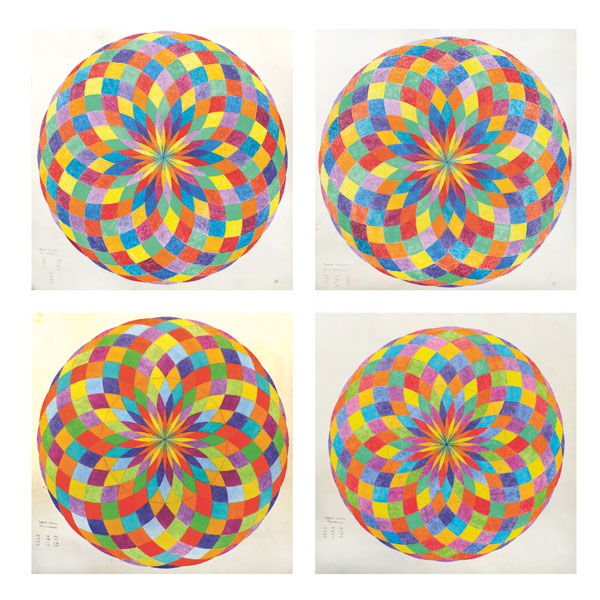
CREATING THE PAINTINGS:
“I do not see myself as an artist. I am a person that is searching for universal truth and I try to find that in mathematics. The drawings are side effects of that search. I am not an entertainer. I don’t say: ‘Watch me’, or ‘Watch my paintings’.
My hope is that the drawings take the emphasis away from the physical to the mental. You need to concentrate to look at it. The more you look at it, the more you concentrate. The painting should attract you.
My paintings follow very specific principles of pure mathematics and the colours express specific meanings of universal philosophic structure. Added are intuitive choices one can make in the search of meaningful and beautiful paintings. I am not creating it, it already exists. I am just manifesting it by painting it. Apart from mathematics and philosophy it all depends on intuition and how it is put together.
Making the painting is a concentration exercise. The reward is not in the finished product, but in the concentration while working on it. I am addicted to the buzz of concentration. What I get out of painting is the ‘now-ness’.
You can be wrong but you don’t really know until you do it. It takes about six months for each painting to make and only then do you know if it is correct. There are so many ways to do it. Errors can be manifold. Lines can be wrong, the system can have internal errors. The aesthetics can be disharmonious or ugly. I don’t know this thing very much; I am on the path of learning. I have so much to do yet.
Even with a good painting, I wonder: ‘Is it correct?’ Lately, I think: ‘Yes, it is pretty correct, but I can do it better.’ And when I figure out how, I start a new one. That happens a lot while I’m working. Mostly I start a new one before finishing the old one.
Hence there are so many unfinished paintings. It is spiritual work in progress.
All previous work is worthless to me. I even burnt a lot of them in the past when they took up too much space. All drawings and paintings that I made since the 1960’s were just preparing me for those that would be complete. Only recently I have made, for the first time, paintings that I consider complete. They are activated in such a way that the colours reflect the god names and are in harmony with the meaning of the mathematical principles of the circles and lines. The new ones are activated, although I really don’t know what that means. Finally, I know how to do it, but I don’t know what effect it will have on what. Surely it will have some effect.
The whole thing is actually an intellectual nightmare – and terrifyingly addictive.”
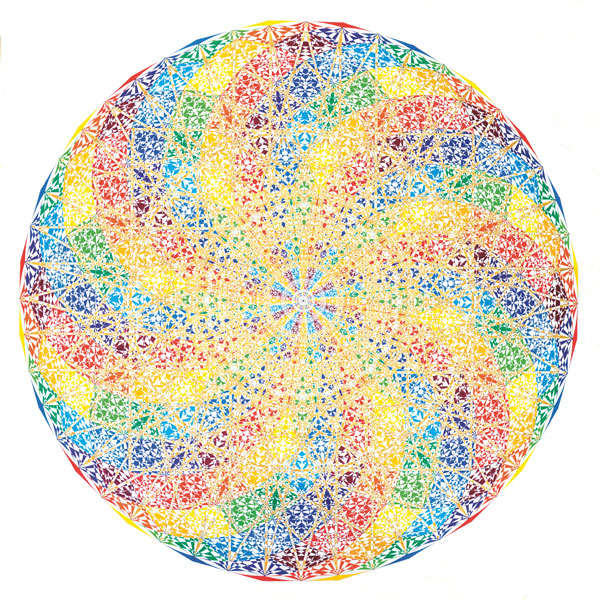
Find out more about Cliff Barker and the Flower of Life and to browse prints for sale, visit: cliffbarber.com




